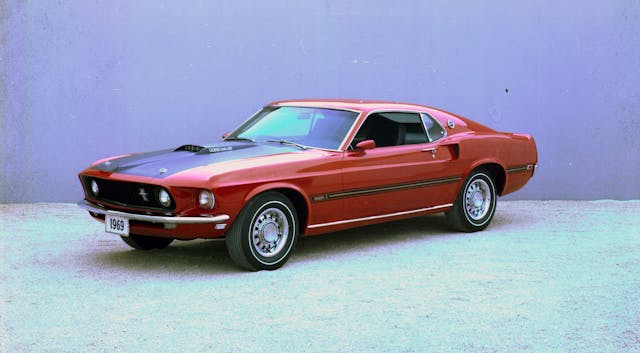Ford and Pontiac fans rejoice, it’s 4/28
We reveled in all things Hemi on 4/26 and lauded Chevrolet’s big-block V-8 on 4/27, so on 4/28 we rightly rain praise on two of the muscle era’s meanest medium-blocks.

Pontiac’s 428 was the largest V-8 available from GM’s sporty performance brand until its bore was expanded to create the 455 in 1970. Intended for its big, burly cruisers like the B-body Catalina and Bonneville–plus the DeLorean-engineered personal luxury offering, the Grand Prix—the 428 would find its way into the GTO and Firebird thanks to dealerships like Royal Pontiac. For a reasonable fee, Royal Pontiac would remove the factory-installed 389 from the Pontiac muscle or pony car of your choice and drop in a tuned, 425-hp version of the 428 that would make your ride one of the most formidable street cars of its day.

Because all Pontiac V-8s from the ’50s through the early ’70s shared external dimensions, you couldn’t distinguish a 326 from a 428 simply by peeking under the hood. While 421-, 428-, and 455-cu-in Pontiac mills used a larger crankshaft journal than the smaller-displacement engines did, their blocks still shared the deck height and bore spacing of the earlier engines that displaced as little as 287 cubic inches. Thus, there’s no Pontiac small-block or big-block; there’s only one Pontiac V-8 engine family.

Also a “medium-block,” Ford’s 428 was part of the FE engine family, so named because they were developed for Ford and Edsel cars. As far as external engine size goes, FE engines and their very similar FT (for Ford Truck) siblings fell in between the small-block Ford Y-block and big-block MEL (Mercury-Edsel-Lincoln) engine families when they were first launched in 1958. FE engines continued to serve as the middle ground between the Windsor and Cleveland small-blocks and 385-series big-block long after their debut.
Tasca Ford is credited with spurring Ford to build the 428 Cobra Jet, the legendary powerplant that gave the Mustang and the Cougar the guts to challenge Ram Air Firebirds and Turbo Jet Camaros. (Of course, the mid-size Torino and Cyclone were also fitted with the powerful 428.) Ford’s mighty 428 Cobra Jet combined the high-flowing heads from the 427 with a serious cam and a dual-plane intake topped with a four-barrel carb. Despite the improved breathing, Ford claimed the 428 Cobra Jet produced 335 hp, just 10 more ponies than a 390 did. We don’t buy it. Figure at least 350 hp, even through cast-iron exhaust manifolds. Take a 428 Cobra Jet to your friendly neighborhood tuning shop, and you’d only improve upon that 350-hp estimate. Ford also offered the Super Cobra Jet, upping the compression ratio with forged aluminum pistons and beefing up the block with four-bolt mains. Breathing was enhanced with a solid-lifter cam. The Cobra Jet 428 proved to be a potent engine in the hands of drag racers, so much so that Ford’s purpose-built drag-racing Mustang once again wears the Cobra Jet moniker.

Ford’s big-bore 427 did steal the spotlight a bit, as it was adopted by both the meanest Shelby Cobras and by the race-winning GT40 that conquered Le Mans in 1966 and 1967; but the 428 was used in some of Ford and Mercury’s muscliest machines as well as in that beautiful blend of Italian bodywork and American power, the AC 428. Ford built flashier FE V-8s–we’ll talk about them in a future article–yet the 428 shines as a hot-rod engine for the masses.
We hope that spring has sprung wherever you are and that April 28 has you enjoying your Ford FE or Pontiac V-8 of any displacement.



The author of this piece doesn’t have a clue what he’s talking about. Royal Pontiac did not pull 389s out of GTOs for their 428 swaps. They pulled out 400s. The 389 didn’t exist anymore at the time. Ford’s 428 Super Cobra Jet did not have higher compression than the Cobra Jet, did not have forged pistons, and certainly did not have cross-bolt mains. The author’s ise of the term “four bolt mains” strongly implies he doesn’t even know the blocks are of a skirted design and that cross-bolting is the way four bolt mains were employed (on 427s and some late 406s, and zero 428s).
There was never a solid lifter cam in the 428 Super Cobra Jet. What became known as the 428 Super Cobra Jet (Ford didn’t actually use the term for the version of 428 Cobra Jet with the Drag Pack option) had durability upgrades but none that changed its power output.